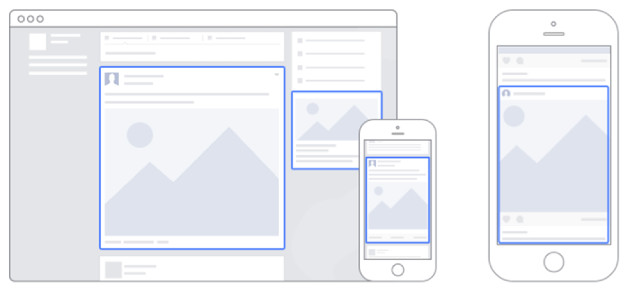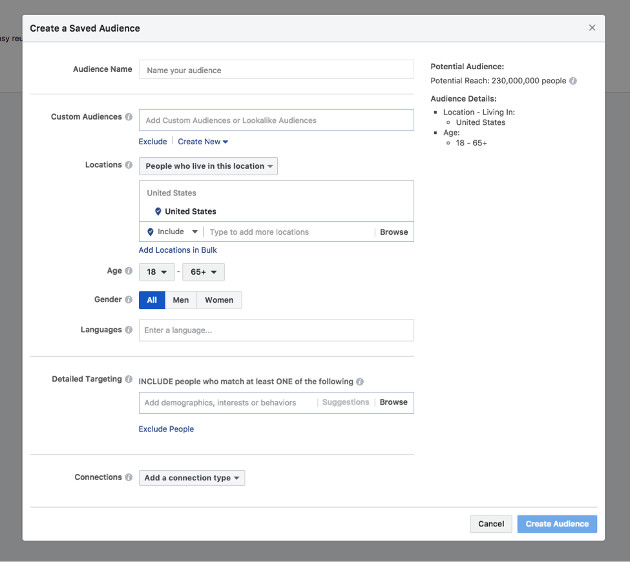With over2 billion Facebook monthly usersas of September 2017, it's no wonder the Facebook Ads platform is becoming a staple of every marketer'ssocial mediastrategy. Facebook is the world's most popular social media platform, and ad spend on its network is booming. Instagram ad revenue alone isexpected to exceed that of Googlethis year, with an estimated $2.81 billion spent by Instagram advertisers worldwide.
Although advertising on Facebook may seem like one of the most immediate ways to achieve impact at a low cost, many marketers aren't seeing the success they're hoping for when they start experimenting with Facebook. Typically one of two scenarios happens with new Facebook advertisers:
- They see low cost-per-click (CPC), but none of these clicks lead to purchases or conversions.
- Their CPC ends up being too high.
What gives?
The best Facebook advertisers understand social ≠ search
The key differences between a social media platform such as Facebook and a search engine like Google are what leaves most new Facebook marketers frustrated: They run their Facebook ads similar to how they manage Google AdWords. And they shouldn't.
With Google, your prospects are searching for you. They know what they need, and they're actively interested in what you're offering. With Facebook, users are simply browsing and socializing, and you're competing with loads of unrelated content. You need ads that are eye-catching and engaging, and ads that drive real value for your potential leads.
How can you achieve that? Let's walk through each of the five things elite Facebook advertisers do differently that you can adopt to elevate your social media marketing.
Note: If you work in digital marketing, I highly recommend tuning into ourPro Webinar series, where we often go over tips and tricks from highly successful marketers working in social media, search, and email.
1. They carefully choose where their ads appear
Facebook currently offers three major ad placements:
- 德sktop News Feed
- 德sktop Right Column
- 手机新闻
 Image Source:Facebook
Image Source:Facebook
Although other ad placements are available, such as within Groups, those three are the most commonly used. Master their pros and cons with the following tips, and you'll immediately begin deploying your ads more strategically:
- 德sktop News Feedtends to be the first go-to option for most marketers, and the priority placement can get you a great conversion rate. The problem is that this Facebook ad placement is both competitive and expensive.
- 德sktop Right Columnads tend to take a backseat to News Feed ads because they're so out of sight, and many marketers don't optimize for the location, and that can lead to overspend. The Desktop Right Column is great for retargeting, but not initial engagement.
- 手机新闻gives you the most bang for your buck on Facebook, and I highly recommend testing out mobile placements. Just as with other ad platforms, the shift from desktop to mobile is aggressively increasing. According toStatista, in 2016 about 97% of Facebook's ad revenue came from mobile advertising. Roughly 1.15 billion daily user access the social network on mobile—a huge audience to use your spend on. Plus, brand discovery and initial engagement can often be had for much cheaper on mobile, so it's definitely in every marketer's favor to use mobile ads.
Pro Tip: If your business does business over the phone,手机新闻can be a powerful placement to drive valuable phone calls to the business. After all, device matters and most mobile devices are smartphones. Make it easy for leads to convert by having a phone call CTA on mobile News Feed ads.
2. They carefully choose who sees their ads
Pro Facebook marketers know that campaigns succeed or fail because of audience targeting. In the world of Facebook Ad optimization, it's critical to know that choosing the right audience is more important than ad creative.
Facebook provides extremely useful advanced targeting options. Master the following three ways to define your audience inside of Facebook Ads Manager, and you'll start to see why it can make or break your efforts:
- Core Audiences:Select your audience manually based on characteristics, such as age, location, interests, and behaviors.
- Custom Audiences:Facebook gives you the ability to securely upload a contact list of people you would like to reach. Although there are several data categories you can upload to create these audiences, the most common are email addresses and phone numbers. (Many of the 70,000+ businesses usingCallRailfor call tracking have had great success with Facebook retargeting by simply uploading their call log to create a custom audience based on caller IDs.)
- Lookalike Audiences:Find people who are similar to your current customer base by building a lookalike audience based on your custom audience.
When choosing your audience, it's critical to keep in mind the ultimate conversion you're aiming for with your campaign. Deciding which audience to use depends on your advertising goal, and whom you're looking to speak to:
- Fornew leads, core audiences and lookalike audiences will be your best friend. These detailed targeting methods can help you bring in new sales from customers that match your current user base. Be sure to exclude a custom audience created from your current customers so you aren't using up precious ad spend on people who have already converted.
- Forcurrent customer upsells or feature activation, uploading your customer list and creating a custom audience is ideal.
- Forretargeting campaigns, I recommend looking into adding theFacebook Pixelto your website or application so you can create a custom audience based on people who have already expressed an interest in your business. You can also upload existing leads in your database as a custom audience.
德fining a clear audience for each Facebook campaign or ad set ensures you aren't wasting your marketing budget on the wrong types of targeting, and help you maximize your ad reach, and conversions.
Pro Tip: If you're using a call tracking provider such as CallRail, you may be able to automaticallyupload leads from phone calls into a Facebook Custom Audiencevia an integration utilizing Facebook's Offline Conversion API. Doing so makes it easier for you to take advantage of retargeting or lookalike audience creation within Facebook by using your most valuable lead source: inbound phone calls.
3. They carefully choose their Ads' call to action
Your Facebook ad is only as good as its CTA and the user experience that follows. It's important to plan out not only whom you're targeting and where,but also how you plan to get them to convert. Every ad you run on Facebook should have a clear CTA, focused on the action you want users to take.
First you will want to decide your marketing objective, then based on that decide what the appropriate CTA is for your campaign or ad set.
Clicks to Website or Website Conversions
With these CTAs, the most important consideration is optimizing the landing page you're sending customers to. If you're running a mobile ad, be sure your landing page is tailored for a mobile experience. According to a study fromGoogle, people who have a negative experience with brands on mobile are 62% less likely to purchase from that brand in the future.
'Call Now' Buttons
Because so many Facebook users are already on mobile, phone-call CTAs are a great way to drive sales from your social marketing ad spend. Available via Local Awareness Ads, this button allows customers to call you right from the ad within their Facebook News Feed. (Learn more about how to drive more call conversions from Facebook Adshere.)
'Send Message' CTA
The new "Send Message" CTA for Local Awareness Ads allows people to initiate private conversations with business Pages from News Feed ads. It gives people a personal way to connect with your business, and it's convenient for the customer. Just be sure you're prepared to respond to customers inquiries if you do use this conversion method.
4.他们仔细的选择如何differentiate their ads
Now that we know who, where, and how the most successful social media marketers set up campaigns on Facebook Ads Manager, it's time to decide the best way todrive engagementwith content from Facebook. Competition is high on the Facebook platform, so it's crucial your ads rise above the noise.
Facebook ran astudyrecently on the top- and bottom-performing campaigns on its platform, and this is what it found:
- For businesses promoting online conversions, the best thing to focus on is your product itself with a clear directive. That means displaying your popular products in the creative, and citing your brand in the copy. Facebook found that if marketers did this well, all other elements were irrelevant to the overall quality score of the ad.
- Another successful approach was a strong focus on brand. That means linking your ad creative and copy to your brand's personality by doing things like showcasing your company's founder or values.
Bottom Line:Rather than showcasing your logos in Facebook ads, spend time creating product-focused images or graphics that help demonstrate your brand's approachability and accessibility.
Another important ad tip to master in Facebook campaigns isad frequency.一个全面的运动特性多个广告all contain relevant messaging and effective creative that can be continually rotated to prevent ad fatigue.
The more people see your same ad, the more bored they get. And even worse, the CPC will increase significantly. One way to combat that is to set up an ad campaign with multiple ad sets with different ads, and schedule each ad set to be active on a different day. By doing so, you'll combat ad fatigue and keep costs per ad low.
5. They continually test and update their ads
As with so many marketing efforts, A/B-testing is your key to success with Facebook ads. Pro Facebook advertisers take this advice to heart and incorporate it into their workflow.
Whether you're new to Facebook ads or a veteran advertiser, it's hard to predict the kind of ad designs that work best for your product or which audience will be more likely to buy. That's why ad experiments with elements such as ad creative, offers, and target audience are used by the best of the best.
If you're just starting out, my recommendation is to A/B-test macro elements—such as which larger message appeals to which audience—versus micro elements, like CTA copy. Doing that can get you off on the right foot and headed in a good direction. Outside of the Facebook ads themselves, it's also best to test the landing pages you're driving ad viewers to.
Then, it's time to consider A/B-testing more specific elements of your ads, such as images, headlines, and main copies.AdEspressostudied data from over $3 million worth of Facebook ads and found the following elements to have the highest split-testing ROI:
- Audience by country
- Audience by precise interest
- Facebook ad goals
- Mobile vs. desktop
- Audience by age ranges
- Audience by gender
- Ad designs
- Titles
- Audience by relationship status
- Landing page
The opportunities for Facebook ad testing are limitless, so these tests can sometimes be cumbersome, but the payoff is great. You'll be able to uncover your most compelling value offer and learn heaps about your audience.
Pro Tip: Consider taking advantage of your martech stack's various Facebook integrations. These integrations will typicallysend conversions directly into Facebook, making it easier for you to track the success of your various campaigns.
Are you ready to start marketing like a Facebook pro?
Knowledge of Facebook marketing is a great asset to have in any marketer's toolkit. As the world's most popular social media platform, Facebook is only going to continue to grow—and the more you know now, the better off you'll be in the future.
These tips will help you keep your Facebook advertising strategy well-considered and fresh, as you continue to experiment with different audiences, ad types, and creative.
Use these tips and you'll start thinking and acting like a pro, improve your Facebook ad efforts, and watch as your cost per lead decreases and your conversion rate increases.








